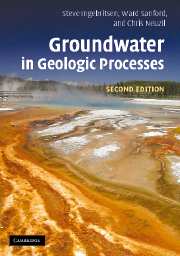Book contents
- Frontmatter
- Contents
- Preface
- Acknowledgements
- List of symbols
- 1 Groundwater flow
- 2 Hydromechanical coupling
- 3 Solute transport
- 4 Heat transport
- 5 Regional-scale flow and transport
- 6 Ore deposits
- 7 Hydrocarbons
- 8 Geothermal processes
- 9 Earthquakes
- 10 Evaporites
- 11 Compaction and diagenesis
- 12 Metamorphism
- 13 Subsea hydrogeology
- References
- Index
1 - Groundwater flow
Published online by Cambridge University Press: 12 January 2023
- Frontmatter
- Contents
- Preface
- Acknowledgements
- List of symbols
- 1 Groundwater flow
- 2 Hydromechanical coupling
- 3 Solute transport
- 4 Heat transport
- 5 Regional-scale flow and transport
- 6 Ore deposits
- 7 Hydrocarbons
- 8 Geothermal processes
- 9 Earthquakes
- 10 Evaporites
- 11 Compaction and diagenesis
- 12 Metamorphism
- 13 Subsea hydrogeology
- References
- Index
Summary
In this chapter we introduce fundamental hydrogeologic concepts and derive the basic equations of groundwater motion. It seems appropriate to begin with Darcy's law, becausewe will generally assume that some form of this empirical law adequately describes rates of fluid flow. Groundwater flow rates calculated by Darcy's law are a unifying theme for this book in that they are used to describe fluid flow through a deforming volume, solute transport by advection and mechanical dispersion, and heat transport by advection. After introducing Darcy's law we will explore associated parameters such as fluid potential, hydraulic head, porosity, hydraulic conductivity, and permeability.We will then introduce the concept of the water table and confined and unconfined groundwater systems, briefly discuss the elemental volume or macroscopic approach that is implicit in the definition of hydrogeologic parameters, and proceed to derive the groundwater flow equation by considering conservation of mass and the production of fluid from “storage” in a geologic medium (introducing specific storage and specific yield). Finally, we will consider the assumptions embodied in various forms of the groundwater flow equation. It will become clear that the commonly invoked forms of the equation, posed in terms of hydraulic head, are too simplified or incomplete to apply to many geologic problems. Nonetheless, they need to be examined and understood as a common point of reference and departure. In succeeding chapters we will develop the coupled theory of groundwater flow and deformation (Chapter 2), solute transport (Chapter 3), and heat transport (Chapter 4), and then describe applications of flow and transport theory to geologic processes (Chapters 5 to 13).
Darcy's law
In 1856 the French engineer Henry Darcy published the results of a set of experiments aimed at developing design parameters for sand water filters. The experimental apparatus, shown schematically as Figure 1.1, allowed him to vary the length (L) and cross-sectional area (A) of a sandpacked column and also the elevations of constant-level water reservoirs connected to the upper (h1) and lower (h2) boundaries of the column. Under steady flow conditions, the volumetric flow rate (Vw/t) through the column (Q) was positively correlated with A and (h1 − h2) and inversely correlated with L.
- Type
- Chapter
- Information
- Groundwater in Geologic Processes , pp. 1 - 37Publisher: Cambridge University PressPrint publication year: 2006



